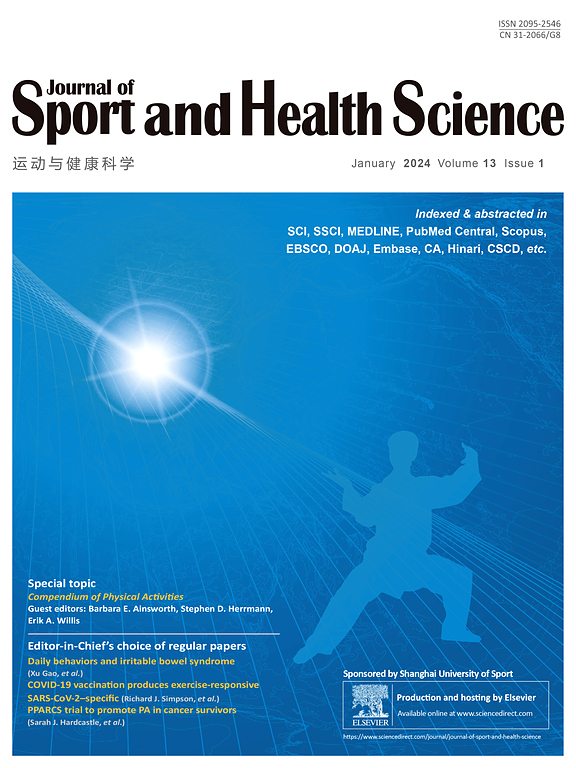Reduced PI3K(p110α) induces atrial myopathy, and PI3K-related lipids are dysregulated in athletes with atrial fibrillation.
IF 10.3
1区 医学
Q1 HOSPITALITY, LEISURE, SPORT & TOURISM
引用次数: 0
Abstract
BACKGROUND Elucidating mechanisms underlying atrial myopathy, which predisposes individuals to atrial fibrillation (AF), will be critical for preventing/treating AF. In a serendipitous discovery, we identified atrial enlargement, fibrosis, and thrombi in mice with reduced phosphoinositide 3-kinase (PI3K) in cardiomyocytes. PI3K(p110α) is elevated in the heart with exercise and is critical for exercise-induced ventricular enlargement and protection, but the role in the atria was unknown. Physical inactivity and extreme endurance exercise can increase AF risk. Therefore, our objective was to investigate whether too little and/or too much PI3K alone induces cardiac pathology. METHODS New cardiomyocyte-specific transgenic mice with increased or decreased PI3K(p110α) activity were generated. Multi-omics was conducted in mouse atrial tissue, and lipidomics in human plasma. RESULTS Elevated PI3K led to an increase in heart size with preserved/enhanced function. Reduced PI3K led to atrial dysfunction, fibrosis, arrhythmia, increased susceptibility to atrial enlargement and thrombi, and dysregulation of monosialodihexosylganglioside (GM3), a lipid that regulates insulin-like growth factor-1 (IGF1)-PI3K signaling. Proteomic profiling identified distinct signatures and signaling networks across atria with varying degrees of dysfunction, enlargement, and thrombi, including commonalities with the human AF proteome. PI3K-related lipids were dysregulated in plasma from athletes with AF. CONCLUSION PI3K(p110α) is a critical regulator of atrial biology and function in mice. This work provides a proteomic resource of candidates for further validation as potential new drug targets and biomarkers for atrial myopathy. Further investigation of PI3K-related lipids as markers for identifying individuals at risk of AF is warranted. Dysregulation of PI3K may contribute to the association between increased cardiac risk with physical inactivity and extreme endurance exercise.房颤运动员PI3K(p110α)降低可诱发心房肌病,PI3K相关脂质失调。
背景:心房肌病易使个体发生心房颤动(AF),阐明其机制对于预防/治疗房颤至关重要。在一个偶然的发现中,我们在心肌细胞中磷酸肌肽3-激酶(PI3K)减少的小鼠中发现了心房增大、纤维化和血栓。PI3K(p110α)在运动中升高,对运动引起的心室扩大和保护至关重要,但在心房中的作用尚不清楚。缺乏运动和极限耐力运动可增加房颤风险。因此,我们的目的是研究单独PI3K过少和/或过多是否会引起心脏病理。方法制备PI3K(p110α)活性升高或降低的心肌细胞特异性转基因小鼠。对小鼠心房组织进行了多组学研究,对人血浆进行了脂质组学研究。结果升高的PI3K导致心脏大小增加,功能保留/增强。PI3K的减少导致心房功能障碍、纤维化、心律失常、心房增大和血栓的易感性增加,以及单唾液二已糖基神经节苷脂(GM3)的失调,GM3是一种调节胰岛素样生长因子-1 (IGF1)-PI3K信号传导的脂质。蛋白质组学分析确定了不同程度功能障碍、扩大和血栓的心房的独特特征和信号网络,包括与人类房颤蛋白质组的共性。结论pi3k (p110α)是小鼠心房生物学和功能的重要调节因子。这项工作为进一步验证候选药物作为潜在的新药靶点和心房肌病的生物标志物提供了蛋白质组学资源。进一步研究pi3k相关脂质作为识别房颤风险个体的标志物是有必要的。PI3K的失调可能与缺乏运动和极限耐力运动增加心脏风险有关。
本文章由计算机程序翻译,如有差异,请以英文原文为准。
求助全文
约1分钟内获得全文
求助全文
来源期刊

Journal of Sport and Health Science
SPORT SCIENCES-
CiteScore
18.30
自引率
1.70%
发文量
101
审稿时长
22 weeks
期刊介绍:
The Journal of Sport and Health Science (JSHS) is an international, multidisciplinary journal that aims to advance the fields of sport, exercise, physical activity, and health sciences. Published by Elsevier B.V. on behalf of Shanghai University of Sport, JSHS is dedicated to promoting original and impactful research, as well as topical reviews, editorials, opinions, and commentary papers.
With a focus on physical and mental health, injury and disease prevention, traditional Chinese exercise, and human performance, JSHS offers a platform for scholars and researchers to share their findings and contribute to the advancement of these fields. Our journal is peer-reviewed, ensuring that all published works meet the highest academic standards.
Supported by a carefully selected international editorial board, JSHS upholds impeccable integrity and provides an efficient publication platform. We invite submissions from scholars and researchers worldwide, and we are committed to disseminating insightful and influential research in the field of sport and health science.
 求助内容:
求助内容: 应助结果提醒方式:
应助结果提醒方式:


